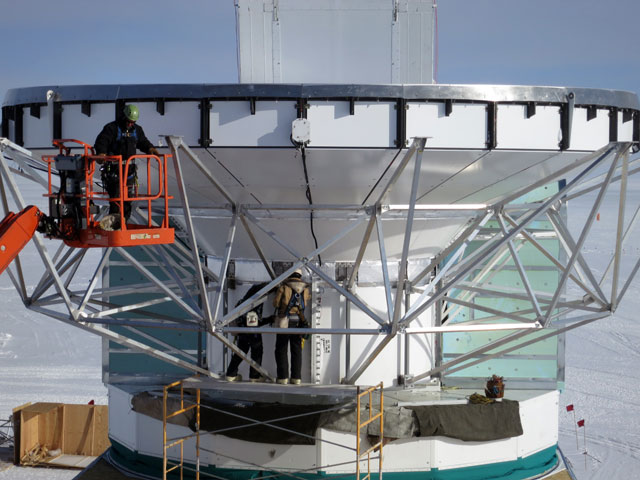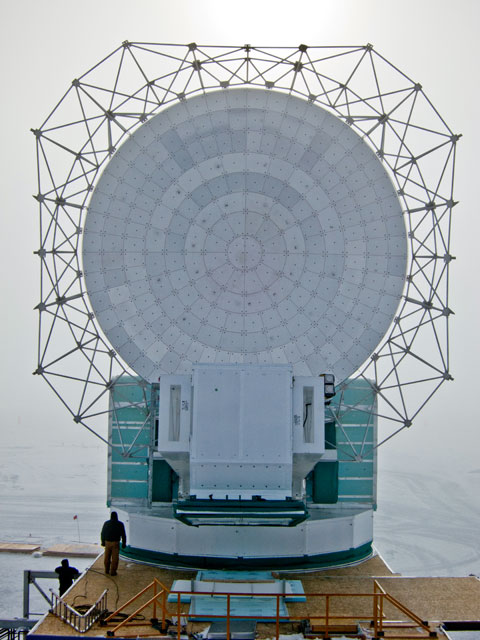Page 2/2 - Posted March 16, 2012
SPT begins new quest for signs of cosmic inflationDuring the 2011-12 season, they swapped the telescope’s high-tech “camera” purposefully designed to detect the SZ effect with one sensitive to the signature left by cosmic inflation on the pattern of the CMB. CMB radiation, often referred to as a faint hiss of microwaves, comes from every direction in the sky. It is almost a perfectly uniform plasma, with a temperature of 2.7 degrees above absolute zero on the Kelvin scale. But it contains “hot” and “cold” spots that are slight irregularities in its near-perfect uniformity, which is known as anisotropy. These spots can tell cosmologists something about the geometry of the universe, the amounts and types of dark matter and energy that make up the cosmos, and even something about the universe’s ultimate fate. The inflation theory holds that the rapid expansion of space-time would generate gravity waves and leave a unique signature when they interact with the plasma. This signature would be a spiral pattern in the polarization of CMB, often referred to as B-mode polarization, which would look like hurricanes in a hypothetical map of the polarization of the CMB. 
Photo Credit: John Mallon III/Antarctic Photo Library
The construction crew poses in front of the SPT with the new ground shield encircling the dish.
“Now, we want to do an even more powerful experiment,” Carlstrom said. Switching experiments required more than just upgrading the technology for the telescope receiver. The shielding that prevents interference from the horizon must be augmented. That meant turning the telescope’s round 10-meter reflector shield into an octagon by extending the shielding around the dish by about 1½ meters. “We’re making a much quieter telescope. Guarding it from the ground, guarding it from the atmosphere, and making sure all the receiver can see is the sky,” Carlstrom noted. The SPT-Pol receiver, for polarization, is a three-year project. While the new experiment will focus on finding the inflation signal, or at least setting new constraints, the SPT will also continue to map galaxy clusters with even more sensitive sensors but on a small pie of the sky. “We’ll go much, much deeper, and do the same kind of science, but much more sensitive than what we have been doing. We’re adding more capability; we’re not walking away from what we’ve been doing, we’re going much deeper with the dark energy experiment,” Carlstrom said. Other telescopes at the South Pole Station In contrast, the SPT focuses on smaller angular scales with greater detail, even delving into particle physics, including revealing characteristics about subatomic particles called neutrinos. Another experiment at the South Pole, the IceCube Observatory “One of our goals is to search in complementary [fashion] with BICEP for B-modes,” Carlstrom said. “We’ll try to measure gravitational waves. At the same time, we’ll do this very cool physics experiment figuring out what the total sum of the masses of the different neutrinos are.” Indeed, the SPT has proven itself to be the Swiss Army knife of CMB telescopes. In addition to mapping galaxy clusters, it has also detected the bright thermal emissions from early star-forming galaxies — something no one expected to see. “It’s a whole new window on the universe that was discovered with that,” Carlstrom said. Benson said the plan going forward in the years to come would be to also measure more of the dusty, star-generating galaxies of the early universe. “We can potentially map out the entire star formation history of the universe, from the very first stars to the peak of star formation in the universe billions of years later,” he said. And that’s just what the SPT has to say about this universe. Carlstrom explained that the theory of inflation, in one interpretation, assumes a pre-existing “piece” of space-time, something almost inconceivably small with such a high energy density capable of inflating the whole universe. “It should happen all the time,” he said nonchalantly. “Inflation gives you an answer to the question, ‘Where did our universe come from?’ It comes from some other space-time. People call it the multiverse.” Astronomy at the South Pole truly has reached the final frontier. “We’re thrilled. We’re excited. We’re just feeding on it,” Carlstrom said. NSF-funded research in this story: John Carlstrom, University of Chicago, Award Nos. 0638937 and 0959620 |



For USAP Participants |
For The Public |
For Researchers and EducatorsContact UsNational Science FoundationOffice of Polar Programs Geosciences Directorate 2415 Eisenhower Avenue, Suite W7100 Alexandria, VA 22314 Sign up for the NSF Office of Polar Programs newsletter and events. Feedback Form |




